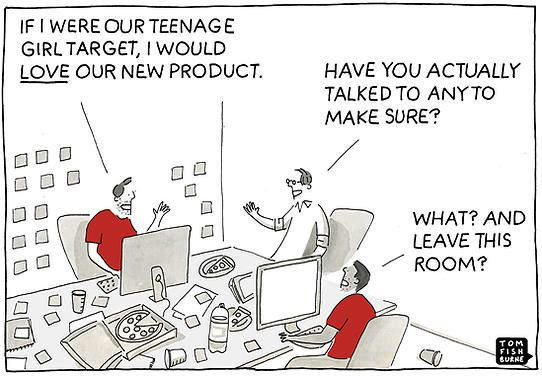From vague ideas to sponsored R & D: a guide to an uncertain start-up
In the previous post, we talked about the final projects of MEGA Accelerator 2, which went from a raw idea to a full-fledged business. But there are many projects that are stuck in the early stages: in search of an investor, motivation or courage to “get out of the dusk”. In this post, the experts of MEGA Accelerator will tell you how to solve the problems that arise in such projects at the beginning of the journey.

Our experts:

')
Daniil Kozlov is Business Development Director and Partner of the Global Venture Alliance. He launched five companies around the world, for 10 years he worked with more than 400 startups from 16 countries.

Alexey Ermolin - Managing Partner of Three Peak Communications. Over fifteen years of operational and marketing experience in leading multinational companies in the B2C and B2B sectors (Sony, Grohe AG).

Nikolai Bobrov - Coach Global Venture Alliance.
I came up with a good idea, but I can not imagine further action. How to
There are many talented engineers and developers with cool ideas in Russia. But on the way of these ideas, negative beliefs stand in the bright future. Here are the most popular examples:
With this attitude, do not go far. What if to make a start from more pleasant thoughts:
This is the first stage, the stage of working with the head. Only after it is reasonable to move on to the idea. The easiest option: imagine yourself an investor and ask a friend to sell you your product. Are you ready to invest your own funds, to make an investment decision?
Well, if you know how to convince and evaluate the idea from different points of view - a client, an investor, a partner. Then you can apply the well-known methods of developing ideas: customer development and business model canvas. The cusdev methodology allows for a series of interviews and tests to clarify product product fit (market market fit). And business model canvas is to formulate a business model and prepare a simple financial calculation for returning investment funds for it.
Alas, nine out of ten investment proposals contain only a request for raising funds, without calculating the return on investment. Do not neglect them.
Here it is important to consider three components:
After that, you do not need to rush into perfectionism, make a minimum viable product (MVP) and collect pre-orders. And of course, do not stop communicating - with potential consumers, partners, investors and other startups.

The best way to get an assessment is to tell about 20-30 experts from the industry and / or potential clients about the project. Let the market appreciate and criticize. You can also perform at open pitch sessions.
Hackatons test the ability of the team, demo days - product readiness. Accelerators help assess the level of business development, the ability to enter new markets or grow on current ones. Accelerators are development programs that pump a startup, ideally giving it a positive “delta” for a number of indicators.
Techniques are great. Any technique that you understand and that works for you is a good tool. The main thing is not to forget the simple truth: business is not science and not art, business is common sense.
The lack of demand for the product is the main cause of start-up failures. If your product is not needed by the consumer, then even the most elegant "paper" business model will not help here. Sometimes startups are overly fond of techniques and forget about it. The only more or less reliable way to make sure that the product is needed is to ask the consumers themselves, and not one or two, but as much as possible.
A properly asked question is half the answer, so there are some techniques here too. In order to correctly ask and receive in response data that will really help create a successful product, I advise you to familiarize yourself with the techniques of the problem and decision-making interview.
First you need to assemble a team in which there will be people with business competencies. Such a team will be able to choose where to go - to accelerators, corporations, development institutions, public or private funds.
If even with business people the team remains at a loss, it is best to go through an easy acceleration program. Or something like GVA Bootcamp, where the idea for two days is broken down into components by different experienced people, is assessed from the point of view of its business viability.
Here the question is not in the national peculiarities. Any investor expects to see a reasonable weighted step-by-step plan for business development. And an entrepreneur often asks at once a large amount of funds, without a guarantee of results. Instead of reducing the risks for everyone and breaking the company's development into small steps with measurable results.
Imagine that you offer a high-tech project with the need to carry out R & D for several years. If it can be divided into quarterly stages, in Russia there will be a sufficient number of interested investors. There would be a good team with an economically viable link between the product and the market.
Before the presentation, the investor needs to deeply work out several aspects of the project. I will list them in descending order of priority:
The idea to protect against theft is almost impossible. Maybe, if only it does not tell anyone. But this is a road to nowhere, since without discussion it is impossible to understand how much an idea is in general in demand and where its weak points are. It is necessary to share with others, especially with people from the industry, and listen carefully to what they say. While there is no product, there is nothing to protect, there is no subject for protection. And if the idea was stolen, it is necessary to quickly bring it to life, and not grieve that someone overheard. Fear of losing an idea is a bright sign of an inexperienced entrepreneur.
The issue of protection is more acute when there is already some product. Certain types of inventions can be effectively protected by a patent, but in the case of software it is difficult and expensive. Here it is better to use registration know-how.
There are many mistakes, but we will single out three main ones.

Our experts:

')
Daniil Kozlov is Business Development Director and Partner of the Global Venture Alliance. He launched five companies around the world, for 10 years he worked with more than 400 startups from 16 countries.

Alexey Ermolin - Managing Partner of Three Peak Communications. Over fifteen years of operational and marketing experience in leading multinational companies in the B2C and B2B sectors (Sony, Grohe AG).

Nikolai Bobrov - Coach Global Venture Alliance.
I came up with a good idea, but I can not imagine further action. How to stop worrying and start living to get off the ground in the direction of business development?
There are many talented engineers and developers with cool ideas in Russia. But on the way of these ideas, negative beliefs stand in the bright future. Here are the most popular examples:
- "In large corporations, you can go only for a bribe."
- “I don’t want to show my idea to the investor because it’s raw.”
- "I just like to create, I do not want to engage in sales."
- "I have such a cool idea that it should be obvious to everyone."
With this attitude, do not go far. What if to make a start from more pleasant thoughts:
- "There are many decent people in corporations who are ready to support me."
- “It’s valuable for me to share ideas with others and improve them through feedback.”
- "I create something useful and I like to exchange my product for money."
- "I can easily change the product, taking into account the wishes of customers and partners."
This is the first stage, the stage of working with the head. Only after it is reasonable to move on to the idea. The easiest option: imagine yourself an investor and ask a friend to sell you your product. Are you ready to invest your own funds, to make an investment decision?
Well, if you know how to convince and evaluate the idea from different points of view - a client, an investor, a partner. Then you can apply the well-known methods of developing ideas: customer development and business model canvas. The cusdev methodology allows for a series of interviews and tests to clarify product product fit (market market fit). And business model canvas is to formulate a business model and prepare a simple financial calculation for returning investment funds for it.
Alas, nine out of ten investment proposals contain only a request for raising funds, without calculating the return on investment. Do not neglect them.
When can one be confident enough that a business idea will have a successful development? And what to do next?
Here it is important to consider three components:
- A sufficient number of potential consumers have expressed their willingness to pay you money when the product is ready.
- You clearly understand how you will earn on the product, and the economy converges at least at the level of financial models.
- You understand what you need to run a project, and where you will take it.
After that, you do not need to rush into perfectionism, make a minimum viable product (MVP) and collect pre-orders. And of course, do not stop communicating - with potential consumers, partners, investors and other startups.

What tools help to get an assessment of your idea? What are the specifics of hackathons, accelerators and other events for these purposes?
The best way to get an assessment is to tell about 20-30 experts from the industry and / or potential clients about the project. Let the market appreciate and criticize. You can also perform at open pitch sessions.
Hackatons test the ability of the team, demo days - product readiness. Accelerators help assess the level of business development, the ability to enter new markets or grow on current ones. Accelerators are development programs that pump a startup, ideally giving it a positive “delta” for a number of indicators.
There are various well-known methods for testing ideas - lean-method, first-mile test, etc. What do you think of them? What can you advise?
Techniques are great. Any technique that you understand and that works for you is a good tool. The main thing is not to forget the simple truth: business is not science and not art, business is common sense.
The lack of demand for the product is the main cause of start-up failures. If your product is not needed by the consumer, then even the most elegant "paper" business model will not help here. Sometimes startups are overly fond of techniques and forget about it. The only more or less reliable way to make sure that the product is needed is to ask the consumers themselves, and not one or two, but as much as possible.
A properly asked question is half the answer, so there are some techniques here too. In order to correctly ask and receive in response data that will really help create a successful product, I advise you to familiarize yourself with the techniques of the problem and decision-making interview.
Who should developers contact if they are ripe to present their business idea?
First you need to assemble a team in which there will be people with business competencies. Such a team will be able to choose where to go - to accelerators, corporations, development institutions, public or private funds.
If even with business people the team remains at a loss, it is best to go through an easy acceleration program. Or something like GVA Bootcamp, where the idea for two days is broken down into components by different experienced people, is assessed from the point of view of its business viability.
There is a widespread opinion that in Russia they can support only that business idea, which is designed for quick receipt of money. It's true? What to do with a long-running project?
Here the question is not in the national peculiarities. Any investor expects to see a reasonable weighted step-by-step plan for business development. And an entrepreneur often asks at once a large amount of funds, without a guarantee of results. Instead of reducing the risks for everyone and breaking the company's development into small steps with measurable results.
Imagine that you offer a high-tech project with the need to carry out R & D for several years. If it can be divided into quarterly stages, in Russia there will be a sufficient number of interested investors. There would be a good team with an economically viable link between the product and the market.
What indicators does the investor pay attention to first?
Before the presentation, the investor needs to deeply work out several aspects of the project. I will list them in descending order of priority:
- The presence of revenue: whether people have learned to sell (even a prototype) or just an idea.
- Unit Economy Balance. There is a monetary indicator LTV (Lifetime Value), which shows how much the client will stay with the company and how much will be consumed. It must be greater than the CAC (Customer Acquisition Cost), which expresses the cost of attracting one customer for the company. The problem is that in most cases the situation is the opposite. And business is like a bucket without a bottom into which you can infinitely pour money.
- Internal rate of return (IRR) and net present value (NPV).
How to protect your business idea from theft during the verification phase? Is this regulated by law, or is Russia lagging behind in this matter? Where and with what to go if the idea was stolen?
The idea to protect against theft is almost impossible. Maybe, if only it does not tell anyone. But this is a road to nowhere, since without discussion it is impossible to understand how much an idea is in general in demand and where its weak points are. It is necessary to share with others, especially with people from the industry, and listen carefully to what they say. While there is no product, there is nothing to protect, there is no subject for protection. And if the idea was stolen, it is necessary to quickly bring it to life, and not grieve that someone overheard. Fear of losing an idea is a bright sign of an inexperienced entrepreneur.
The issue of protection is more acute when there is already some product. Certain types of inventions can be effectively protected by a patent, but in the case of software it is difficult and expensive. Here it is better to use registration know-how.
And finally: what are the most common mistakes startupers make? Where do business ideas fail most often?
There are many mistakes, but we will single out three main ones.
- Focus on product and technology instead of focus on the consumer and his problems. The most common problem for Russian startups
- Unprocessed business model.
- Unwillingness to learn to talk about the product. This is a complex problem, which includes the organization of a competent pitch with public speaking, and the creation of presentations, and networking.
Source: https://habr.com/ru/post/349126/
All Articles